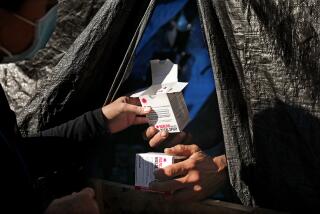Chronic Diseases Affect Poor Areas More
- Share via
Poorer areas in Los Angeles have a higher incidence of chronic diseases such as diabetes and more risky behaviors such as drug and alcohol use than more wealthy locales, a new county health report found.
Health officials found the extent of the geographic disparities in health status and access to health care disturbing. South-Central and downtown were hardest hit.
The report, released Wednesday, was based on surveys by the Los Angeles County Department of Health Services as well as other state and county organizations.
“The disparities should outrage those who really care about the health of our residents,” said Dr. Jonathan E. Fielding, director of public health at the county Department of Health Services.
“It’s a call for help, but more than that, it’s a call for stronger collaborative efforts and to make sure that we are doing everything that can be done to improve the health of adults and children.”
The south area, which includes South-Central, Lynwood and Compton, has the highest rate of births to teens and the lowest access to prenatal care, according to the report.
It leads the county in incidences of breast cancer, heart disease death, cervical cancer and diabetes.
It also has the highest rate of obesity and the highest number of uninsured adults and children.
The metro area, which includes West Hollywood and downtown Los Angeles, had twice the tuberculosis rates of the San Gabriel and San Fernando valleys and nearly three times the state AIDS rate.
Cheryl Wold, chief of the health assessment unit at the Los Angeles County health department, said the agency felt the need to release the information because it “wants the information in the hands of the people who can act” to change the situation.
“We want to do everything we can to reduce disparities in health,” she said. “We issue reports like these because we know we can’t do this alone.”
The report shows the importance of promoting healthy behavior in the areas that are affected most, she added.
Poor communities tend to have higher rates of substance abuse as well as obesity, which Fielding called a “prescription for disaster” because of its link to cancer and heart disease.
Countywide, only about one in 10 adults consumes the recommended servings of fruits and vegetables a day. More than 40% reported getting little or no exercise a day. This behavior is even more prevalent in low-income areas.
“We need aggressive outreach,” said Councilman Mark Ridley-Thomas, whose district includes parts of South Los Angeles.
“We need information in schools, libraries, religious institutions, anywhere people would turn. There should be billboards. We need a full-on assault against everything that diminishes and deteriorates the quality of health.”
He said he is committed to boosting enrollment in health insurance programs for the poor, such as Healthy Families and Medi-Cal.
Belinda Towns, a county health officer in the south division, said the report helped the department identify health problems and compelled her to assemble community groups to target them.
She said they will focus on decreasing risky sexual behavior, increasing physical activities among children and seeking ways to expand prenatal care and insurance coverage. The plans are still in the beginning stages, she said, but if they get cooperation from school and city officials and other organizations, “we should be able to make a dent.”
Fielding agreed, adding that collaborative efforts have helped the county reduce smoking and improve immunization.
“It’s important that we use [the information], and [that it] not stay on the shelf,” he said.
More to Read
Sign up for Essential California
The most important California stories and recommendations in your inbox every morning.
You may occasionally receive promotional content from the Los Angeles Times.













